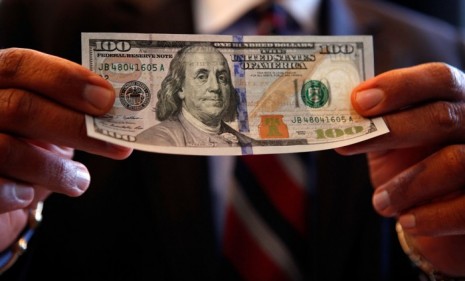The government's $110 billion currency goof
Washington is destroying reams of flawed $100 bills after a massive printing error. How did this happen?

The new $100 bill, set to debut in February, was designed to foil counterfeiters with high-tech touches, such as a 3D strip and a color-changing Liberty Bell. But the complex design has led to an embarrassing snafu. On Monday, CNBC reported that a printing error rendered more than one billion of the new notes defective, leaving the government scrambling to separate good bills from bad ones, and make sure enough currency is in circulation. How did a much-hyped "Benjamin" fix turn into such an embarrassment? (Watch Jon Stewart slam the Fed on "The Daily Show.") Here's a guide to what went wrong:
What exactly is the problem?
During printing, a significant portion of the new notes experienced "a creasing problem in which paper folds over during production," leaving blank spots on some of the bills. At one point, the imperfection affected 30 percent of the new $100s rolling off the presses.
The Week
Escape your echo chamber. Get the facts behind the news, plus analysis from multiple perspectives.

Sign up for The Week's Free Newsletters
From our morning news briefing to a weekly Good News Newsletter, get the best of The Week delivered directly to your inbox.
From our morning news briefing to a weekly Good News Newsletter, get the best of The Week delivered directly to your inbox.
How much money are we talking about?
The face value of the bills is a staggering $110 billion, or 10 percent of the U.S. currency in circulation.
What has happened to the flawed bills?
The government has stored them in "huge vaults" in Forth Worth, Texas, and Washington, D.C. They are being held in "cash packs," with each pack containing 16,000 bills. The government is attempting to develop a "mechanized system" that will distinguish usable bills from useless ones. Sorting them by hand would take more than 20 years, officials estimate.
A free daily email with the biggest news stories of the day – and the best features from TheWeek.com
How did this happen?
Nobody is certain. Printing money involves a few different parties. There is Crane and Co., which has supplied currency paper since 1879, and the Bureau of Engraving and Printing, which actually produces the money. Then there is the Federal Reserve, which issues it. While nobody knows what caused the error, tensions are running high, and accusations between the parties are flying. "The Fed’s very unhappy," one insider says, "and the Bureau of Engraving and Printing is taking a beating unnecessarily. Somebody has to pay for this."
How much will this mistake cost?
These "new Benjamins" cost more to produce than the older ones — nearly 12 cents apiece versus 8.5 cents for an earlier version. So the government spent about $120 million to produce the problem-plagued bills. It's not clear yet how much it will cost to sort through them to find usable currency.
What is Washington doing in the meantime?
The Treasury is printing old $100 bills that bear the signature of Henry Paulson, George W. Bush's Treasury secretary, and that do not feature the new anti-counterfeit design. (Timothy Geithner, the current holder of the position, can take solace; his name does appear on current $1 and $20 bills.) While it's unclear how long it will take to fix the problem, "numerous government officials expressed confidence that the majority of the $100 bills bearing Geithner's signature will be found acceptable" eventually.
Sources: CNBC, The Washington Post


